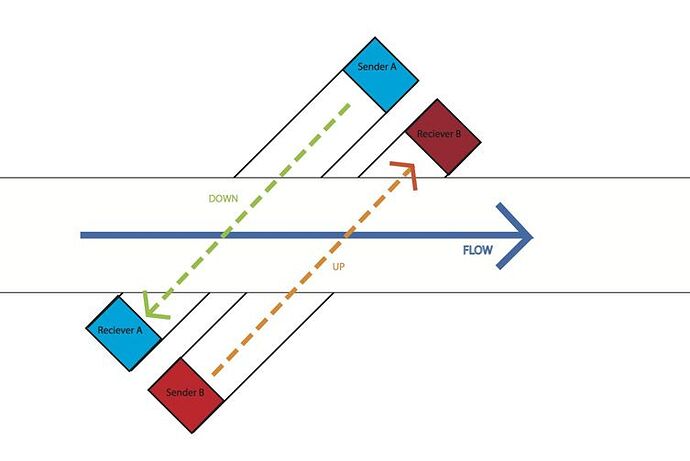I want to make a prototype of an ultrasonic flow meter. I rarely found any examples of this case and I it is difficult to make this prototype fairly accurate.
This is the case:
I want to measure airflow (breathing) in a tube (diameter: 21mm)
I have two ultrasonic sensors: SRF05 and SRF08, I disconnected both senders and wired them up again so I can arrange the sender and the receiver of one sensor facing each other.
To start of I made some calculations to find out if this is actually feasible.
Ultrasonic flow measurement is based on the doppler effect:
the downwards signal will be slowed down by the airflow, the upwards signal will be accelerate.
The difference in time between those two signals determine the flow.
Tdown = L / ( c + Vcosq )
Tup = L / ( c - Vcosq )
so if:
r = 21 mm = 0,021 m
d = r / sinq = 29,7mm = 0,0297 m
q = 45°
c = 340,29 m/s
A. In case F = 0 l/min
Tup = Tdown = L/c = 87,2785 μs
--> I probably have to widen the diameter of the tube as the signal is to close to the minimal range of the sensors.
B. In case flow = 5 l/min = 83,33 * 10^-6 m3/s
F = 5 l/min
V = F/A = 60,3840 * 10^-3 m/s
(flow die we minimaal willen kunnen registreren)
Tdown = L / ( c + V*cosq )
= 87,2675 μs
Tup = 87,2894 μs
Δt = Tdown – Tup
= 0,0219 μs
= 21,9 ns
--> The measurement needs a accuracy of minimal 10ns (nanosecons)
So when looking at the arduinoboard I found that most of them have a clock speed of 16 MHz so they can give a accuracy of 62,5 ns, this would not give desired data.
However: the arduino due board has a clock speed of 84MHz witch would give a resolution of 12 nanoseconds, what comes very close to what I would actually need.
Can someone give me advice on this case?
Do you think the arduino due board could do the job?
